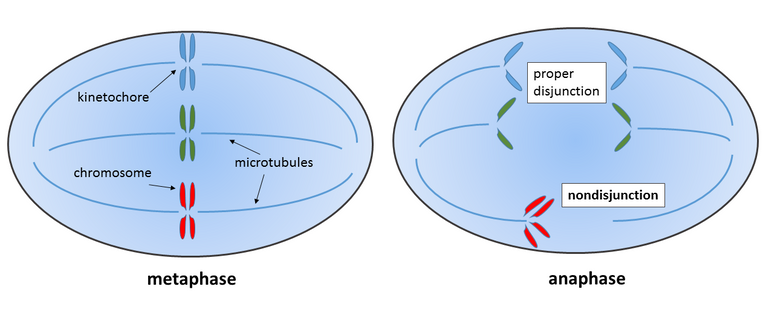In the human population, the incidence of Down syndrome stands at an average of one out of seven hundred births while that of Turner syndrome stands at an average of one out of five thousand births.source In addition, about one out of five hundred male births suffer from Klinefelter syndrome. All these syndromes are as a result of chromosomal aberrations and are usually characterized with abnormal conditions ranging from learning disabilities and predisposition to autoimmune diseases to endocrinologic disorders and cancers.source

Apart from cognitive impairments, individuals with Down syndromes usually have a wide variation of peculiar characteristics such as dry skins, congenital heart defects, slurred speeches, hearing losses, dysmorphic features among other characteristics. source Moreso, Down syndrome survivors are usually males as females are not known to survive the aberration.
Individuals with Turner syndromes are known for normal intelligence and are mostly females due to the fact that the condition has been found to be deleterious in the male gender. The majority of females with this syndrome have a characteristics short stature and experience early loss of ovarian functions In addition, some individuals might possess webbed neck, lymphedema, as well as heart defects.source
Klinefelter syndrome is peculiar to the male gender only and mainly characterized by hypogonadism, gynecomastia, oligospermia, behavioural issues, among other features. source
Genesis of chromosomal aberrations
The genesis of individuals having an abnormal number of chromosomes stems from gamete formation. Gametes are usually formed during meiosis while male and female gametes only combine during fertilization to bring about a zygote that eventually leads to an individual.
A normal human has 23 pairs (2n = 23) of chromosomes. Each pair of chromosome become halved during meiosis in sex cells and each half of the 23 pairs is inherited by gametes. This means that each gamete only has a haploid number (n = 23) of chromosome. However, this situation only happens when the process of gamete formation happens without any error.
In some rare cases during meiosis, mistakes do happen when some chromosomes refuse to separate at the metaphase stage. This refusal leads to a situation in which some daughter cells - and gametes, of course - have extra chromosomes while some have fewer chromosomes than normal. The implication of this is that when such gametes participate in fertilization, the resulting zygotes will either have too many or too few chromosomes than normal - a condition known as aneuploidy.
When aneuploidic condition leads to a zygote having an extra chromosome than normal (47 instead of 46), it is known as a trisomy condition. When the reverse occurs (45 instead of 46), it is known as monosomy condition.

The phenotypic interpretation of trisomy in humans is Down syndrome or Klinefelter syndrome. Down syndrome occurs when the extra chromosome is associated with non-sex determining chromosomes, otherwise known as autosomes. Klinefelter syndrome results when the extra chromosome is associated with the sex-determining chromosome in males (XXY instead of XY). In some rare cases, Klinefelter syndrome results from XXYY/XXXY (48 chromosomes) conditions or XXXXY (49 chromosome) conditions.source
A typical monosomy condition in humans is Turner syndrome. The missing chromosome has to be a non-sex determining chromosome because there has never been any report of fetuses surviving missing sex chromosomes.
Chromosomal aberrations in some other organisms
Abnormal chromosomal conditions also occur in plants. However, those aberrations that have economic implications have gained the attention of scientists. An imbalance in the number of chromosomes has been reported to be responsible for some physical defects in plants source, although plants are generally known to be more tolerant of aneuploidy conditions than animals.source
In some cases, organisms inherit a complete set of an extra chromosome instead of a chromatid. For example, if the normal chromosomal condition of an organism is diploid (2n); a 3n version of the organism has an extra set of chromosomes while a 2n+1 version only has an extra chromosome/chromatid.
Generally, organisms with a complete set of extra chromosomes are said to be polyploids and the condition is referred to as polyploid. Thus, 3n organisms are said to be triploids (triploidy), 4n are tetraploids (tetraploidy), etc.
Polyploid conditions are deleterious in humans and generally in most vertebrates. The conditions are, however, found in non-vertebrates such as fishes and amphibians. Polyploid is most desirable in agriculture because crops with an extra set of chromosomes often have a higher yield than those with a normal set of chromosomes.
Thank you for reading.
Most people with Down syndrome around here don't get adequate attention. They often suffer discrimination from family and the society at large. If only they know the genesis. Education is key, thanks for the enlightenment.
Thanks for your contribution to the STEMsocial community. Feel free to join us on discord to get to know the rest of us!
Please consider supporting our funding proposal, approving our witness (@stem.witness) or delegating to the @stemsocial account (for some ROI).
Please consider using the STEMsocial app
app and including @stemsocial as a beneficiary to get a stronger support.
Excelente contenido
Felicidades Excelente Contenido👏👏